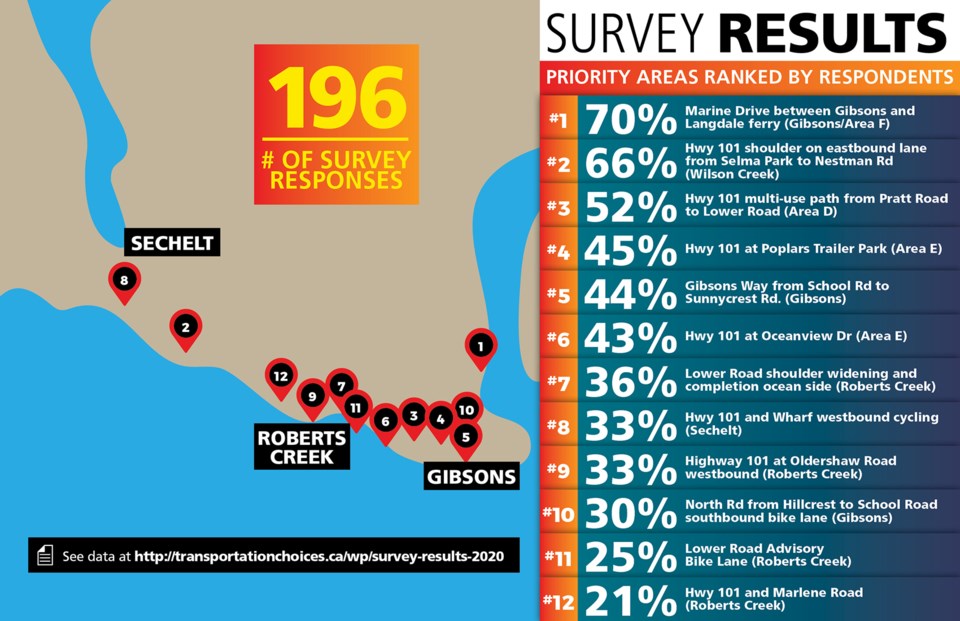Results from a survey by a local cycling advocacy group have identified 12 locations along Highway 101 and other well-used roads in need of safety improvements and infrastructure upgrades, and reveal concerns about what many respondents say are dangerous biking conditions.
The survey, conducted by Transportation Choices (TraC) in June and released Sept. 22, asked the 1,000 people on its mailing list to select which of 12 predetermined locations on the Sunshine Coast were most in need of improvements.
Of the 197 respondents, 92 per cent cycle on the Sunshine Coast.
Marine Drive from Langdale to Gibsons, Highway 101 eastbound between Selma Park Road and Nestman Road, and between Pratt Road and Lower Road in Area E were ranked the three areas of highest priority.
“The Marine Drive hill in Granthams is a fatal accident waiting to happen,” said one survey respondent. Another called the Selma Park section “really frightening” due to
“large vehicles passing and the hazard of many driveways to watch out for.”
In an accompanying report, TraC said it wants a cycling and walking link to connect the ferry terminal with Gibsons, a marked paved shoulder “of consistent width and quality” installed at the Selma Park stretch, and a multi-use path installed on the south side of Highway 101 between Pratt and Lower Road “to allow for off-highway cycling and walking,” in addition to upgrades for the nine other ranked locations.
Survey respondents also requested more clearing of debris from bike lanes and shoulders, more separated bike lanes with improved paving and marking, and a dedicated “ferry to ferry” route that could be used by locals and to promote cycle tourism.
In 2019 organizers of the Gibsons Grind Gran Fondo cancelled their event, which drew hundreds of off-coast cyclists, citing safety concerns.
On top of the ranked priority areas, TraC said “much of the cycling and walking infrastructure” on the Sunshine Coast “is unsafe or not enjoyable in locations,” there is “inadequate” separation from vehicles, and dangerous highway crossings and “road shoulders are poorly constructed and not maintained.”
The group wants to see the completion of shoulders along Highway 101, regular maintenance of shoulders and the “creation of a continuous coast-wide non-highway route using secondary roads.”
The survey was created to provide more information about cycling needs following a meeting with Ministry of Transportation and Infrastructure (MOTI) staff in June to review issues related to active transportation on the Sunshine Coast.
TraC isn’t the only group to identify the need for cycling infrastructure improvements.
A long-anticipated Highway 101 corridor study, also released in September, identified “gaps in sidewalks and bike lanes between origins.”
That study found on rural sections of the highway the shoulder “is not wide enough for pedestrians and cyclists to remain separated from the vehicle travel lane.”
It also “identified locations in Gibsons and Sechelt with discontinuous cycling lanes and sidewalks and noted that infrastructure for pedestrians and cyclists along the corridor could be improved along with future road projects.”
TraC president Alun Woolliams told Coast Reporter in an email the study was “a lost opportunity to identify and prioritize a lot of missing active transportation infrastructure.”
The group had met with local MOTI staff before the corridor study “and it was clear there is no local funding to implement the policies laid out in B.C.’s active transportation strategy Move, Commute, Connect,” said Woolliams.
“We are therefore concerned there is no planning or no money being invested in this important active transportation infrastructure.”
The survey can be read in full here: http://transportationchoices.ca/wp/survey-results-2020/
TraC is organizing Active Transportation Week with events from Sept. 28 to Oct. 4.



